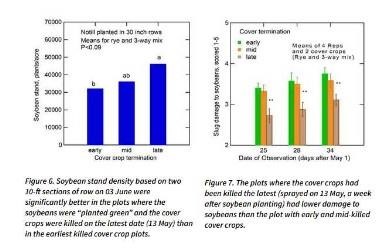By Paige Garrabrant and Rachel Cochran
Last week, OSU Extension’s Water Quality Team launched their annual webinar series with a two-part webinar on cover crops. The team works closely with producers throughout the Western Lake Erie Basin to implement practices that not only improve growers’ operational efficiencies and profitability, but also to promote soil health and reduce nutrient and sediment loss. Several producers that the team works with have requested more education specifically on cover crops.
The webinar last week focused on cover crops with a handful of different speakers. Tim Reinbott, Director of Field Operations at the University of Missouri’s Agricultural Research Stations, provided listeners with some insight and advice on controlling slugs and voles, which are common in no-till and reduced-till situations. His goal is to help growers control pests while maintaining progress they have made toward conservation. It is no surprise that the benefits of reduced tillage cannot outweigh the loss of crops that results from a devastating slug or vole infestation.
Slugs prefer cool, wet environments and require a high protein diet (aka germinating crop seeds). Typically, we see the most slug damage to soybean crops because their growing point is above ground and therefore accessible to slug feeding. Unfortunately, in soybean crops, slug damage is typically widespread before the grower realizes they’re there. Tim provided us with some easily implemented cultural control methods. He suggested planting seeds deeper, at around 2 inches. He warned growers to be cautious with insecticide use, as these applications can destroy communities of beneficial insects. He also advised growers to plant green and terminate cover crops later in the spring. Lastly, when selecting cover crop seed, select a mix conducive to your goals: for example, erosion control or nutrient scavenging ability. Tim also mentioned that slugs tend to avoid radish, so utilizing a cover crop mix that contains this species could be of benefit.
Voles are another pest that farmers continue to struggle with. When present, damage caused by these varmints is prolific and devasting. Like other rodents, these mammals breed rapidly, with some females bearing up to 40 young per year. Voles prefer to bed under cover; typically living in grassed waterways or buffer strips where cover is thick and dense. Therefore, one control option is mowing or burning the waterways. However, this can be disruptive to our goals of introducing beneficial organisms such as pollinators into our ecosystem. Therefore, it is suggested you burn or mow down the waterways in early spring to disrupt whatever has grown there. Planting green and planting crop seeds deeper can also lessen the impact of voles. Because this is also a method of controlling slug damage, these practices are highly recommended. Cover crop variety is also important. Voles will favor grasses such as cereal rye and legumes such as clover, hairy vetch and alfalfa. Alternatively, they do not like canola. The last control method is to rely on natural enemies such as coyotes and hawks.
Tim shared a study conducted by Mellisa Stefun, Graduate Student, Soil and Watershed Sciences at the University of Maryland, in 2021 on planting green. The study showed soybean stand in late-terminated cover crops as much more successful than those terminated earlier. Moreover, the study showed the least slug damage to soybean crops that had covers terminated late than those terminated early.

Source : osu.edu